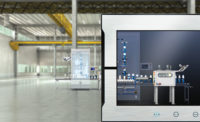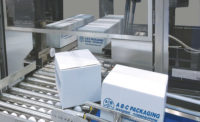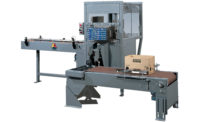Even with today’s packaging machines representing the state-of-the-art in terms of flexibility and quick changeover, the packaging and processing equipment industry must continue to offer solutions that solve problems associated with demographic trends, changing consumer preferences and the disruptions in retailing caused by e-commerce. Some of these issues include:
- Growing cultural and age diversity in the workforce.
- A technology skills gap among workers.
- Leaner maintenance teams required to know more and do more.
- Increasing variation in products and package configurations to case pack, palletize, and stretch wrap.
- Shorter product lifecycles.
- E-commerce companies requiring greater flexibility on the packaging line.
- Brick and mortar retailers demanding greater customization to differentiate themselves from their online cousins.
- Every customer asking for greater speed of fulfillment.
The next stage in the evolution of packaging automation is in more intuitive HMI.
Beginning in 2015, our product development team researched control platforms, motion control technology, data integration at distribution centers, the Industrial Internet of Things (IIoT), and commercial and societal trends such as workforce diversity and worker skill gaps. We wanted to understand what capabilities must be included on our next-generation stretch wrapping machines scheduled to roll out in 2016. It quickly became apparent that discussions of servo motors, variable frequency drives, IO-Link enabled devices, greater versatility in wrap patterns, increased pre-stretch capabilities and all of the other “mechanical” oriented requirements for stretch wrapping machines were vital but basically offered incremental advancements for customers. Four areas, on the other hand, stood out as potential game changers in terms of giving customers a competitive edge. We found that the following points would be important for most automation today, not simply stretch wrappers. These were:
- A human machine interface (HMI) strategy that enables a diverse, multi-language workforce to optimize stretch wrapping performance during every shift regardless of daily changing conditions.
- A remote monitoring capability that enables lean maintenance teams to keep the machinery running at peak efficiency while team members deal with a myriad of other responsibilities.
- Machine and warehouse management system data integration that increases the distribution center’s responsiveness to retailers and other customers, streamlines operations and optimizes cube utilization.
- A single scalable control platform across models that brings machines to market faster, simplifies training and makes it possible for fast effective upgrades for every customer’s unique environment.
Many of these features are available today but not necessarily all inclusive on machines. The key point is for packaging specifiers to identify packaging machines that have most of these features as standard, and the features are incorporated cost effectively, bringing the benefits down to entry and mid-level machines as well as top-of-the-line solutions.
The following are attributes to consider that make stretch wrap and other automated systems easier to use and maintain:
What to Look for in HMIs
When specifying a new automated packaging machine, look for a high-definition touchscreen display that measures at least 5.5 inches (140 mm) at the low end and at least 7 inches (178 mm) or larger at the high end. The larger and more defined the display, the more data that can be presented and the easier it is for the operator to see, understand, and manipulate icons and images.
Machines must use still images, video, and/or illustrations to show operators where on a machine a fault can be cleared and how to clear that fault.
For the last several years, OEMs have been redesigning HMIs to be more icon-based because today’s operators feel comfortable with smart phone and tablet navigation. The problem sometimes has been that the icons are designed by engineers and are not user friendly. When evaluating an automated packaging machine, go ahead and start it up. Ask yourself, was the process intuitive? Were there issues trying to back out when navigating to a home screen? If so, that is a problem. Going to a function or backing out of one should be accomplished on average in two taps. An easy to use HMI gives workers more power to solve problems and keep the flow of packages moving. It also builds operator confidence and improves morale.
Remote Monitoring Is Essential
The HMI as described above gives a diverse workforce an intuitive way to solve problems as part of daily operations and keep the process flowing. New controls can perform the same function for maintenance personnel, but in a different way. On new machines, each of which can be assigned an IP address through the HMI, cycle counts run in the background on a maintenance dashboard. Maintenance personnel simply click on the machine’s icon from any authorized devices on the plant intranet to immediately access cycle counts and other key pieces of maintenance and runtime information. Remote monitoring must be made available to upper level managers responsible for multiple locations. Maintenance dashboards should show all the critical information to help maintain optimum throughput and it should be customizable. Accessible data should include all key performance indicators. For example, in a stretch wrapper the dashboard will show:
- Current wrap recipe
- Top wraps
- Bottom wraps
- Force to load
- Amount of tension
- Machine idling or running
- All machine settings, including lifecycle (cycle) counters and shift counters. With cycle count and number of loads, maintenance personnel know when to service the machine and purchasing personnel can order film on a just-in-time basis.
- The system diagnostics manager, also part of the dashboard, allows maintenance personnel access to troubleshooting tools down to I/O level devices.
Only authorized personnel enabled by the end user’s IT departments may access this information. Remote monitoring provides secure 24/7 access to information and tools that help effectively allocate resources while maintaining maximum throughput.
Machine/Warehouse Management System Data Integration
The machine’s PLC or industrial computer must excel at timely, seamless transfer of data to warehouse management systems. Realtime data enables greater organizational flexibility. Information from a stretch wrapper for example will include product location, pallet size, weight, and time of processing. Some end users might like to tie load dimensioning applications into the mix for insight into greater cube utilization.
A Single Scalable Control Platform
Packaging equipment suppliers that have many different standard models of machines should strive to have common control platforms and graphic interface strategies across models. The benefits of a scalable solution include:
- Time to market for delivery of new machines is faster when the control architecture is scalable.
- Customer tech support improves when the OEM and distributor’s support teams intimately know one control platform rather than many.
- Spare parts and inventory requirements decrease.
- Customers gain operational advantages when there is a similar look and feel between machines.
- System updates come more frequently and effectively when there is a unified platform.
It is easier and faster to have updates delivered via USB stick inserted into a port on an industrial computer versus dealing with specialized cables and software to update a PLC.





